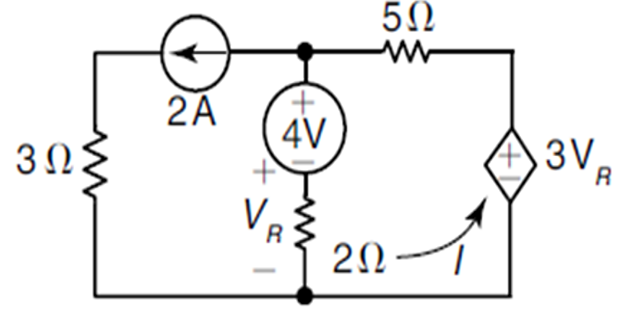Solved Problems on Kirchhoff's Voltage and Current Laws (KVL & KCL)
Demonstrative Video
Problem-1
Find v0v0 and i0i0 in the given circuit?

Solution-1
KCL at first node AA : 9=i0+i1⇒i1=9−i09=i0+i1⇒i1=9−i0
KCL at second node BB : i1=i04+i2⇒i1=i04+v08i1=i04+i2⇒i1=i04+v08
substituting the first in second, we get 9−i0=i04+v08⇒9−v08=5i04
Also, VA=VB=V0=2i0
Therefore, 9−v08=5i049−i04=5i04i0=6 Av0=2i0=12 V
Problem-2
Obtain the current I in the network?

Solution-2
Applying KVL in Loop-2 3VR−5I−4−VR=0⇒2VR=5I+4
Applying KCL at Node-A I1=I−2
Now, VR=2I1=2I−4
On substitution 2(2I−4)=5I+4⇒I=−12 A
Problem-3
Obtain the current i in the network?

Solution-3
KVL in first loop gives 5=2I1⇒I1=2.5 A
Va=I1=2.5 V
KVL in second loop 4Vab=4i⇒i=Vab
Vb=i
Vab=Va−Vb=2.5−i=i
Hence, i=1.25 A
Problem-4
Determine the following in the circuit
VR2
V2 if VR1=1

Solution-4
KVL in first loop gives −8+12−VR2=0⇒VR2=4 V
Also applying KVL VR2−7+9−vx=0⇒vx=6 V
Again applying KVL vx+v2+3−vR1=0⇒v2=−vx−3+vR1=−8 V
Problem-5
The voltage source in the given circuit has a current of 1A flowing out of its positive terminal into resistor R1 .Calculate the current labelled i2.

Solution-5
1=i2−3+7⇒i2=−3 A
Problem-6
Determine the value of the voltage v ?

Solution-6
Applying KCL
1+2=v5+5+v5−2=2v5v=−5 V
Problem-7
Find the current ix in the circuit shown?

Solution-7
Applying KCL at three nodes 4mA+3i1+V5 kΩ+V20 kΩ=0i1=3i1+V20 kΩ3i1+V20 kΩ=ix
Solving the first two and then putting in third, we get ix=0.57 A
Problem-8
For the given circuit, use the KVL to find the branch voltages V1 to V4?

Solution-8
Applying KVL in 4 loops 3−V1+V3=0V1+V2+2=0−4−V3−V4=0V4−2−5=0
V4=7V V3=−11V V1=−8V V2=6V
Problem-9
Determine the value of vx labelled in the circuit?

Solution-9
Voltage at first node 2.3−500mA×7.3=−1.35V
Applying KCL at first node 0.5+1.35=I2
Therefore vx=−1.35−1.85×2=−5.05V
Problem-10
The current Ix in the circuit given ?

Solution-10
Applying KCL at node V−1100+V100=10 mA
Then, Ix=V100
Ix=10 mA